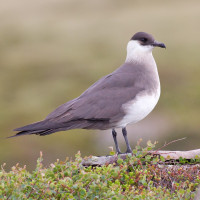Descrizione
Breezanddijk is a small hamlet on the famous "Afsluitdijk". Before the dyke was constructed, the area was a shallow sandbar in the former Zuiderzee and became a working base when construction started. Nowadays, the area contains a gasstation, campsite and a small harbour. The "island" is mostly covered in low vegetation, but several scrubs and small trees are present. During migration, these areas are great for migration songbirds that travel across the lake and rest here. In the last decade, species like Pigliamosche pettirosso and Luì di Pallas turned up here.
The waters surrounding the island are what really makes the area a good spot for birding. In winter, large flocks of Moretta grigia rest mostly on the southern side of the dyke. Other waterbirds that can be seen here are Smergo minore, Smergo maggiore, Quattrocchi and Pesciaiola. The harbour contains calm waters and provide a great resting area for gulls.
In Autumn, the area is a great spot for large numbers of Sterna comune and Mignattino comune. Also, large numbers of Gabbianello tend to migrate through the area.
The northern side of the dyke gives a great view over the Wadden Sea. Many seabirds can be seen here, like flocks of Edredone and Moretta grigia. During Autumn migration, the area is also great for scarce species like skuas, such as Labbo and Stercorario maggiore. Other rare seabirds that turned up here are Gabbiano glauco, Gazza marina minore and Marangone dal ciuffo.
_________________________
Nederlands: Breezanddijk ligt aan de Afsluitdijk. Voordat de dijk werd aangelegd, was het gebied een ondiepe zandplaat in de voormalige Zuiderzee en werd het een werkbasis toen de bouw begon. Tegenwoordig bevat het gebied een tankstation, camping en een kleine haven. Het "eiland" is grotendeels bedekt met lage vegetatie, maar er zijn verschillende struiken en kleine bomen aanwezig. Tijdens de vogeltrek zijn deze gebieden geweldig voor trekzangvogels die hier rusten. In het afgelopen decennium doken hier soorten als Pigliamosche pettirosso en Luì di Pallas op.
De wateren rond het eiland maken het gebied echt een goede plek om vogels te kijken. In de winter rusten grote groepen Moretta grigia vooral aan de zuidkant van de dijk. Andere watervogels die je hier kunt zien zijn Smergo minore, Smergo maggiore, Quattrocchi en Pesciaiola. De haven biedt een rustplaats voor meeuwen. In de herfst is het gebied een geweldige plek voor grote aantallen Sterna comune en Mignattino comune. Ook trekken grote aantallen Gabbianello door het gebied.
De noordkant van de dijk geeft een prachtig uitzicht over de Waddenzee. Hier zijn veel zeevogels te zien, zoals groepen Edredone en Moretta grigia. Tijdens de herfsttrek is het gebied ook goed voor schaarse soorten zoals jagers, zoals Labbo en Stercorario maggiore. Andere zeldzame zeevogels die hier opduiken zijn Gabbiano glauco, Gazza marina minore en Marangone dal ciuffo.
Dettagli
Accesso
The area is easy accessible and provides many locations which give a nice overview of both the northern and southern part of the dyke.
_________________________
Nederlands: Het gebied is goed bereikbaar en biedt veel plekken die een mooi overzicht geven van zowel het noordelijke als het zuidelijke deel van de dijk.




